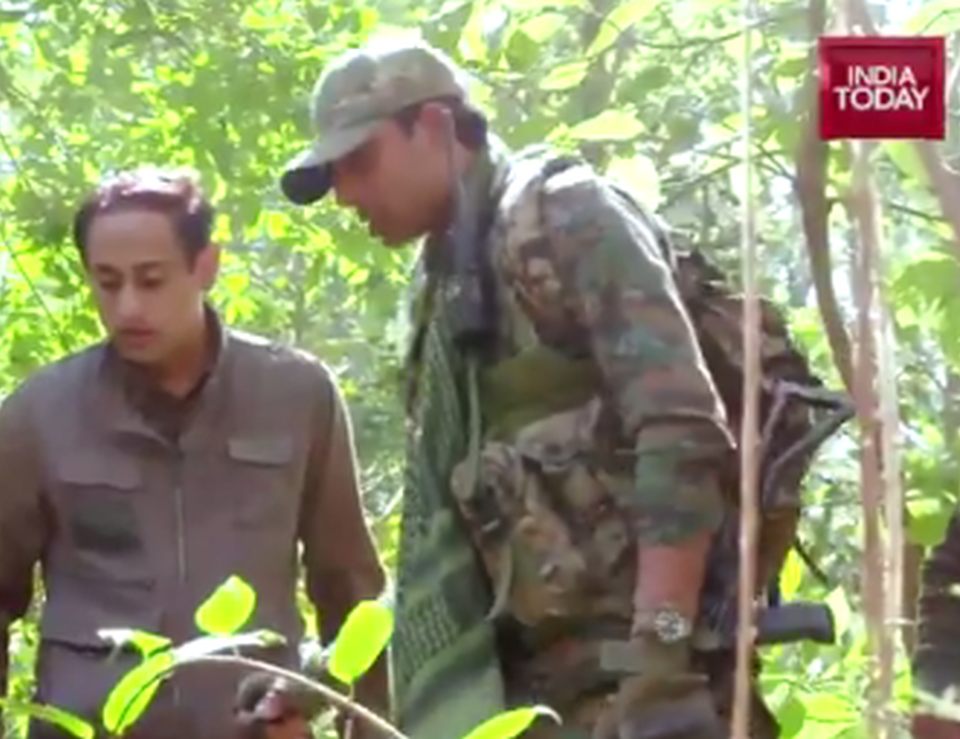
Journalists covering conflict: How to stay safe and live to tell the story!
Forget India Today anchor Rahul Kanwal’s ridiculous GI Joe shenanigans aired on the eve of the elections in Chhattisgarh today, how do ‘real’ journalists stay safe and still get the story when they are cover conflict in Bastar? Here’s a quick primer put together by Malini Subramaniam.
The tragic death of Doordarshan cameraperson Achyutanand Sahu near Nilawaya village, Dantewada district in Chhattisgarh, has put the spotlight on the perils of journalism in conflict zones. Sahu, along with reporter Dhiraj Kumar and lighting assistant Mormukut Sharma, were riding on bikes with security forces for pre-election coverage when they were attacked.
Journalists in Bastar like Kamal Shukla and Prabhat Singh have spoken about the problems they have faced, targeted by the police for investigating atrocities by security forces against the villagers. Journalists like Santosh Yadav and Somaru Nag have been arrested on trumped up charges, face court cases for sedition charges and when they venture into the forests, face gruelling interrogation from the security forces on their return.
Covering Bastar is very tenuous and a situation fraught with danger. Trusting the right sources, maintaining one’s independence from the government, the security forces, the Maoists and the vigilante groups and still managing to move about in conflict zones, meeting villages and getting the story is a really difficult task. But, it is possible, with these simple guidelines:
1. AVOID THE GOVERNMENT: It is important to understand that the Maoists do not knowingly target civilians. However, for civilians, it is important to avoid people who could be in their target. Security personnel are definitely on top of the list. There have been instances of officials in administration who have been harmed, even to the level of the District Collector. In Bastar, a collector was abducted and one got caught in an ambush as he was traveling with a local politician. So, if journalists are going to cover government news or even go on election coverage or any other state event, it is better to avoid travelling with the government officials or security forces. Travelling with a lower functionary is still safer.
2. AVOID THE SECURITY FORCES: The Security forces are the Maoists’ apparent target of attack, primarily so that they can loot weapons and secondly, to stall their work of providing protection to construction activity, especially road, usually as a convoy or in large numbers or to a targeted political party member. Security personnel do move about in civilian clothes, travel by bus, etc. They are safer if they do not carry weapons.
3. AVOID CIVILIAN TARGETS: Targeted civilians are those who are contractors, usually road contractors who take on contract when they clearly oppose it, or labour contractor, etc. Seldom have the Maoists targeted labourers working in construction activity. They have been threatened, perhaps even abducted and beaten and threatened, but rarely killed.
(There have been rare instances of Maoists killing government functionaries like a patwari, tehsildar, teacher, doctor, anganwadi worker etc. There are, however, several cases of abduction and of beating of people and even killings of those who inform police or are involved in corruption issues or don’t attend to work.
Two journalists have been killed so far – Sai Reddy and Naimichand Jain. The Maoists claimed that the killing of Sai Reddy was a’ mistake’, a totally lame and shocking admission. In the case of Jain, no such admission was forthcoming as the Maoists claimed that Jain was a police informer).
SO WHO DO JOURNALISTS RELY UPON FOR INFORMATION?
1. TRUST THE RIGHT ‘SOURCES’: It is important to know whom to trust. The most reliable people who know things on ground are of course the villagers.
2. The second most reliable are the local journalists. If the reporter is biased, meaning someone who is not sensitive or responsive to the issues of the local people, that reporter will definitely be under watch by the Maoists. These reporters may then be threatened, beaten or abducted.
3. BEWARE OF THE VIGILANTES…: In Bastar, vigilante groups have been in operation for several years now and the police and security forces work in tandem with them. Some local journalists are part of these groups. They may mislead and even videograph the independent journalists if they happen to meet any local cadre. Some of these groups have, along with the police, threatened the journalists that they will file cases against them.
4. ….BUT KEEP IN TOUCH WITH THEM: Most often, these journalists who are also members of the vigilante groups are themselves scared of venturing too much into the interiors for reporting. So they would actually have very little authentic information. But it’s important to know such persons and keep track of what they say and represent.
Perhaps it is time to consider other ways in which journalists/ reporters working in security sensitive areas are distinguished in some way, along the lines of the Red Cross, which makes them stand apart even from a distance so that they are not targeted. Of course, this would need a universal recognition tag and enough propaganda so that villagers, the armed rebels, security personnel, government, the local administration etc., know and recognize it from a distance. Sure, it may be misused, but at least we can then get some cloak of protection.
After all, we are clear that we journalists are not armed nor are we playacting at cops-n-robbers! We come to the area for the sole and specific purpose of reporting! No more shooting of messengers!
Story first appeared in freespeechcollective.in on the 12th Nov 2018
STORY BY

Mumbai Press Club
Editor
Article posted on 13/11/2018
- Share This Story On:




